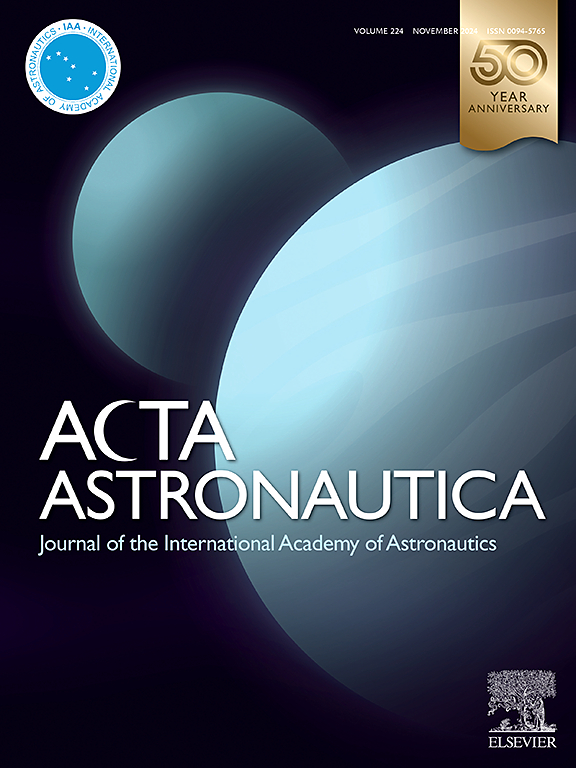通过可微编程缩小 SGP4 与高精度传播之间的差距
IF 3.1
2区 物理与天体物理
Q1 ENGINEERING, AEROSPACE
引用次数: 0
摘要
简化一般扰动 4(SGP4)轨道传播模型是快速可靠地预测绕地球运行物体的位置和速度的最广泛使用的方法之一。随着时间的推移,SGP 模型不断改进,以提高其效率和准确性。在本研究中,我们引入了 SGP4 的一个新的可微分版本,命名为 ∂SGP4。通过将 SGP4 的源代码移植到基于 PyTorch 的可微分程序中,我们开启了可微分轨道传播的全新技术,包括航天器轨道确定、状态转换、协方差相似性转换、状态转换矩阵计算和协方差传播。除了可微分性之外,我们的∂SGP4还支持在单次执行中并行传播一批双线元素(TLE),而且由于运行在PyTorch后端,它可以利用GPU或XLA设备(如TPU)等现代硬件加速器。此外,∂SGP4 的设计使其有可能在更大的机器学习(ML)管道中用作可微分的组件,其中传播器可以是用数据训练或微调的更大神经网络的一个元素。因此,我们提出了一种新的轨道传播范式--ML-∂SGP4。在这一范例中,轨道传播器通过连接到其输入和输出端的神经网络得到增强。通过基于梯度的优化,这个组合模型的参数可以通过迭代改进达到超越 SGP4 的精度。从根本上说,当传播器遵循 SGP4 所定义的默认行为时,神经网络就像身份算子一样发挥作用。然而,由于∂SGP4 中根深蒂固的可微分性,可以利用星历数据对模型进行微调,以学习修正 SGP4 的输入和输出。这种增强可提高精度,同时在推理时保持与 ∂SGP4 相同的计算速度。这种模式赋予卫星运营商和研究人员权力,使他们有能力使用自己的特定星历或高精度数值传播数据来训练模型。本文章由计算机程序翻译,如有差异,请以英文原文为准。
Closing the gap between SGP4 and high-precision propagation via differentiable programming
The simplified general perturbations 4 (SGP4) orbital propagation model is one of the most widely used methods for rapidly and reliably predicting the positions and velocities of objects orbiting Earth. Over time, SGP models have undergone refinement to enhance their efficiency and accuracy. Nevertheless, they still do not match the precision offered by high-precision numerical propagators, which can predict the positions and velocities of space objects in low-Earth orbit with significantly smaller errors.
In this study, we introduce a novel differentiable version of SGP4, named SGP4. By porting the source code of SGP4 into a differentiable program based on PyTorch, we unlock a whole new class of techniques enabled by differentiable orbit propagation, including spacecraft orbit determination, state conversion, covariance similarity transformation, state transition matrix computation, and covariance propagation. Besides differentiability, our SGP4 supports parallel propagation of a batch of two-line elements (TLEs) in a single execution and it can harness modern hardware accelerators like GPUs or XLA devices (e.g. TPUs) thanks to running on the PyTorch backend.
Furthermore, the design of SGP4 makes it possible to use it as a differentiable component in larger machine learning (ML) pipelines, where the propagator can be an element of a larger neural network that is trained or fine-tuned with data. Consequently, we propose a novel orbital propagation paradigm, ML-SGP4. In this paradigm, the orbital propagator is enhanced with neural networks attached to its input and output. Through gradient-based optimization, the parameters of this combined model can be iteratively refined to achieve precision surpassing that of SGP4. Fundamentally, the neural networks function as identity operators when the propagator adheres to its default behavior as defined by SGP4. However, owing to the differentiability ingrained within SGP4, the model can be fine-tuned with ephemeris data to learn corrections to both inputs and outputs of SGP4. This augmentation enhances precision while maintaining the same computational speed of SGP4 at inference time. This paradigm empowers satellite operators and researchers, equipping them with the ability to train the model using their specific ephemeris or high-precision numerical propagation data.
求助全文
通过发布文献求助,成功后即可免费获取论文全文。
去求助
来源期刊

Acta Astronautica
工程技术-工程:宇航
CiteScore
7.20
自引率
22.90%
发文量
599
审稿时长
53 days
期刊介绍:
Acta Astronautica is sponsored by the International Academy of Astronautics. Content is based on original contributions in all fields of basic, engineering, life and social space sciences and of space technology related to:
The peaceful scientific exploration of space,
Its exploitation for human welfare and progress,
Conception, design, development and operation of space-borne and Earth-based systems,
In addition to regular issues, the journal publishes selected proceedings of the annual International Astronautical Congress (IAC), transactions of the IAA and special issues on topics of current interest, such as microgravity, space station technology, geostationary orbits, and space economics. Other subject areas include satellite technology, space transportation and communications, space energy, power and propulsion, astrodynamics, extraterrestrial intelligence and Earth observations.
 求助内容:
求助内容: 应助结果提醒方式:
应助结果提醒方式:


